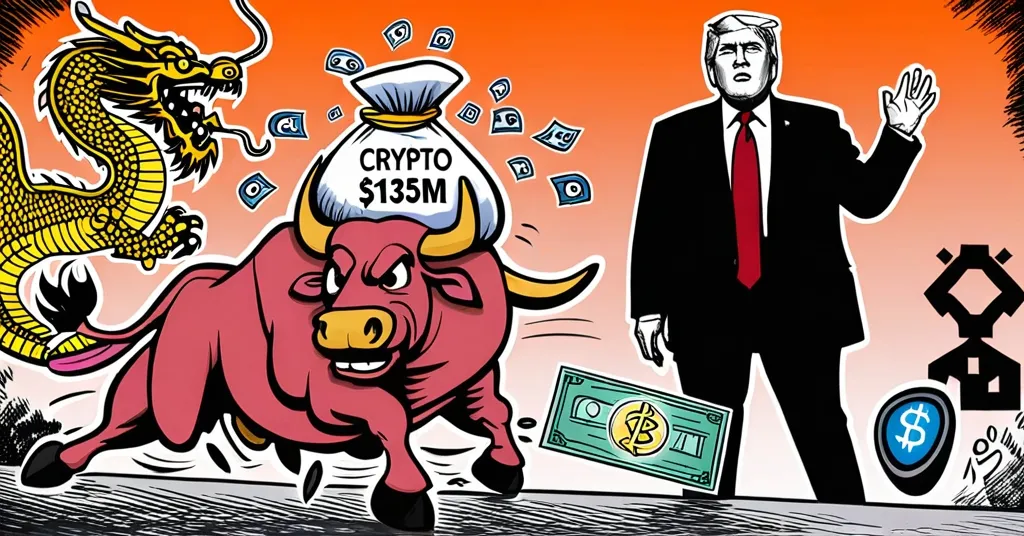Crypto Industry Bets $135M on Trump, Faces Global Challenges

The Crypto Industry’s High Hopes for Trump: A Reality Check
As Donald Trump gears up for his 2025 presidency, the crypto community is betting big on a future that could redefine digital currencies. With a whopping $135 million in campaign contributions, they’re hoping for a golden era. Yet, the global financial scene is shifting rapidly, and these high expectations might need a serious reality check.
- Crypto industry donates $135 million to Trump
- Expectations include fewer SEC lawsuits and a U.S. Bitcoin reserve
- Europe’s new stablecoin regulations pose risks
- China’s mBridge project challenges U.S. dollar dominance
- Tokenization gains traction in Asia
U.S. Crypto Hopes
The crypto world has gone all in on Trump, expecting him to be the golden ticket to a more favorable environment. Their wishlist includes fewer lawsuits from the Securities and Exchange Commission (SEC), the U.S. government agency that regulates securities markets, smoother banking access, and even the establishment of a U.S. Bitcoin reserve. This reserve would be a national stockpile of Bitcoin, potentially bolstering the country’s financial position and integrating digital assets into the mainstream economy.
Trump’s potential appointees, Paul Atkins and David Sacks, are seen as crypto-friendly. Atkins, eyed for the SEC chair, and Sacks, appointed as the White House “crypto czar,” could steer U.S. policy in a direction that the industry dreams of. However, the rise of deposit tokens—blockchain-based money backed by traditional banks and deposit insurance—suggests Western central banks are exploring alternatives to stablecoins, adding a layer of complexity to the financial ecosystem. These tokens offer a different approach to digital currency, one that’s more closely tied to existing banking systems and perhaps more palatable to traditional financial institutions.
European Regulatory Challenges
Europe, however, is stirring the pot with new rules effective December 30, 2024, that mandate stablecoins like Tether’s USDT to maintain 60% of their reserves in traditional bank accounts. Tether CEO Paolo Ardoino has raised the alarm, warning of “incredibly big systemic risk” due to these regulations. This could spell disaster for stablecoin stability and liquidity, especially in regions where these digital assets serve as a lifeline for financial inclusion. The potential delisting of USDT in the EU could disrupt liquidity, fragment markets, and hinder innovation, a scenario that’s far from the crypto utopia some were dreaming of.
“This could lead to ‘incredibly big systemic risk.'” – Tether CEO Paolo Ardoino on European stablecoin regulations.
China’s mBridge Initiative
Across the globe, China is making bold moves with its mBridge project, aiming to dethrone the U.S. dollar’s dominance in global transactions. mBridge is a digital platform that uses blockchain technology to facilitate international trade, potentially reducing reliance on the U.S. dollar. This initiative could cut the dollar’s role in 36% to 40% of global trade, a significant blow to U.S. financial dominance. It’s a chess move in the ongoing geopolitical game of finance, one that could redefine global economic power dynamics.
Asian Tokenization Surge
Meanwhile, Asia is racing ahead with tokenization, the process of converting assets into tradable tokens on the blockchain. This trend is booming in Hong Kong and Singapore, where the market is expected to balloon to $4 trillion by 2030, according to Citigroup. This surge in tokenization comes as interest in Central Bank Digital Currencies (CBDCs) wanes, with only 13% of central banks now seeing them as the future of cross-border payments, down from 31% the previous year. The shift towards tokenization highlights Asia’s proactive stance in leveraging blockchain for asset management and financial innovation.
“Tokenization could be a $4 trillion market by 2030.” – Citigroup’s prediction.
While the crypto industry might be dreaming of a Trump-led revolution, the global landscape tells a different story. From Europe’s tightening grip on stablecoins to Asia’s push towards tokenization and centralized blockchain initiatives, the world is moving in its own direction. The crypto community’s wishlist might be ambitious, but achieving it in the face of these global developments could be a much tougher challenge than anticipated.
Crypto Industry’s Hopes and Global Challenges: Key Insights
-
What are the crypto industry’s expectations from President Trump?
The crypto industry expects fewer SEC lawsuits, better banking access, and possibly a U.S. Bitcoin reserve.
-
How are Europe’s new regulations affecting stablecoins like USDT?
Europe’s new rules require stablecoins like USDT to keep 60% of their reserves in traditional bank accounts, which could pose systemic risks according to Tether’s CEO.
-
What is China’s mBridge project, and how does it challenge U.S. financial dominance?
mBridge is a cross-border payment system using digital currencies to bypass SWIFT and U.S. scrutiny, potentially reducing the demand for the U.S. dollar in global transactions.
-
What is tokenization, and why is it gaining importance in Asia?
Tokenization is the process of turning assets into tradable tokens on the blockchain. It is gaining importance in Asia due to its potential to become a $4 trillion market by 2030, with regions like Hong Kong and Singapore leading the way.
-
How has interest in CBDCs evolved recently?
Interest in CBDCs has declined, with only 13% of central banks seeing them as the future of cross-border payments, down from 31% the previous year.
-
Who are the key figures in Trump’s administration related to crypto policy?
Paul Atkins, a potential SEC chair, and David Sacks, the White House “crypto czar,” are key figures expected to influence crypto policy.
-
What are deposit tokens, and how do they differ from stablecoins?
Deposit tokens are blockchain-based money tied to traditional banks and backed by deposit insurance rather than 1:1 reserves like stablecoins.



